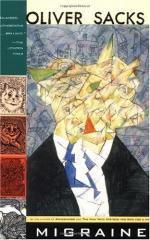
|
| Name: _________________________ | Period: ___________________ |
This test consists of 5 multiple choice questions, 5 short answer questions, and 10 short essay questions.
Multiple Choice Questions
1. Sacks concludes the book by talking about how there is a tendency for the ________ to take on specific patterns.
(a) Doctor.
(b) Migraine.
(c) Patient.
(d) Universe.
2. Sacks points out that some drugs simply work for migraines, even though they don't have any ________ basis for this.
(a) Supported.
(b) Research.
(c) Chemical.
(d) True.
3. Sacks wants to point out that many doctors and researchers __________ too much from the data they receive in order to find these answers.
(a) Reason.
(b) Understand.
(c) Guess.
(d) Extrapolate.
4. One researcher describes the presence of __________ work patterns during some migraine events.
(a) Art.
(b) Grill.
(c) Impressionistic.
(d) Lattice.
5. In some cases, all three of the possible hallucinations can be seen during a single migraine ________, according to the author.
(a) Lifetime.
(b) Week.
(c) Year.
(d) Event.
Short Answer Questions
1. More ________ hallucinations can not be created in the lab setting, according to Sacks and his research.
2. Some people who have constant migraines that interrupt their life may have to _________ to live with them.
3. The intensity of the pain of a migraine is directly related to the dilation of the _________ arteries in the head, according to research.
4. Many of the patterns that are created are often _________, according to Sacks, which is why further research is needed.
5. To deny a migraine sufferer the use of ___________ would be cruel, according to Sacks in this book.
Short Essay Questions
1. What does Sacks point out is more needed in the animal world than in the human world?
2. What sort of person does Sacks say is someone who might actually be self-destructive or may have a desire toward self-punishment?
3. What determines the frequency with which a doctor should see their migraine patients?
4. Where did Ralph Siegel, PhD work when he co-authored the last chapter with Oliver Sacks, according to the footnote?
5. What are the three categories of hallucinosis, according to the last section of the book?
6. How does Sacks recommend a patient with nausea deal with their medication ingestion to ensure pain relief?
7. What did Airy believe that migraine hallucinations allowed a person to do as a result of their appearance?
8. What happens when Sacks has a patient who will only agree to be treated with medications for their migraines?
9. What is the correlation that Sacks discounts because of a lack of studies of migraine patients?
10. Why was Lashley mostly dismissed by his contemporaries in the migraine research field, according to the last section of this book?
|
This section contains 622 words (approx. 3 pages at 300 words per page) |

|




